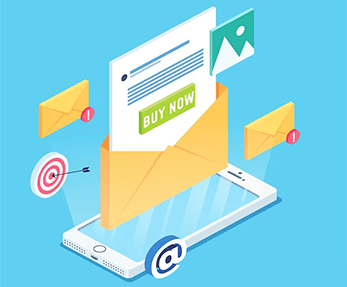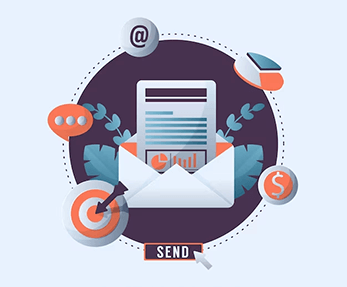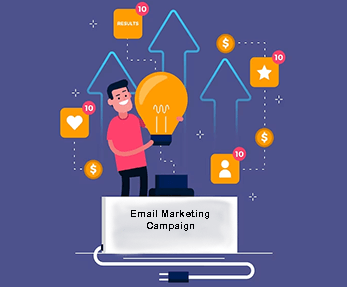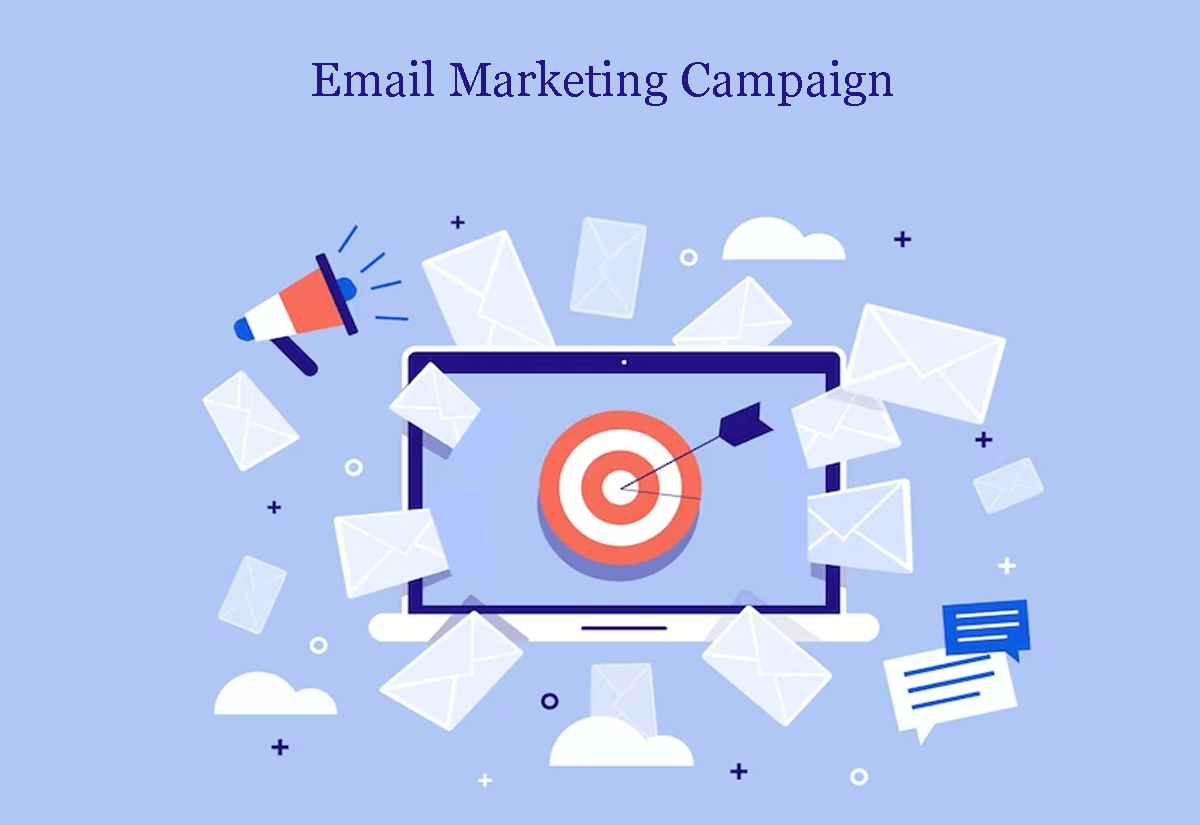What's Inside?
Introduction to Email Marketing Campaign:
In today’s fast-paced digital landscape, where meaningful customer engagement is paramount, Email Marketing Campaigns stand as a cornerstone of successful communication strategies. These campaigns wield the power to forge strong connections, deliver personalized content, and drive conversions like no other channel. By effectively leveraging the potential of email, businesses can unlock a direct and impactful avenue to reach their target audience.
An Email Marketing Campaign is more than just sending messages; it’s a strategic approach that involves careful segmentation, personalized content creation, and data-driven optimizations. In this era of information overload, crafting compelling and relevant emails that resonate with recipients is essential. From nurturing leads to re-engaging dormant subscribers, the versatility of Email Marketing Campaigns empowers businesses to achieve a myriad of goals.
This journey delves into the core concepts of Email Marketing Campaigns, exploring their definitions, underlying strategies, various types, and real-world examples. Whether you’re a budding entrepreneur or an established brand, understanding the nuances of this powerful tool will equip you with the knowledge to navigate the dynamic realm of digital marketing and create impactful connections that drive success.
What is an Email Marketing Campaign?
An email marketing campaign is a series of marketing emails that are sent to a specific group of subscribers with the aim of achieving a specific goal, such as increasing sales, driving traffic to a website, promoting a new product or service, or simply engaging with subscribers. An email marketing campaign usually involves creating a series of emails that are sent out at regular intervals over a period of time, such as a few days, weeks, or months. The content of each email is carefully crafted to resonate with the target audience and encourage them to take a desired action, such as making a purchase or filling out a survey. The success of an email marketing campaign is typically measured by the open rate, click-through rate, conversion rate, and other metrics that help evaluate the effectiveness of the campaign.
Types of Email Marketing Campaigns
 There are various types of email marketing campaigns, each serving a specific purpose and catering to different stages of the customer journey. Here are some common types of email marketing campaigns:
There are various types of email marketing campaigns, each serving a specific purpose and catering to different stages of the customer journey. Here are some common types of email marketing campaigns:
1. Welcome Emails:
- Sent to new subscribers or customers who have recently joined your email list or made a purchase.
- Introduce your brand, set expectations, and provide a warm welcome.
- Often include a thank-you message, a brief introduction to your products/services, and a call-to-action.
2. Promotional Emails:
- Designed to promote specific products, services, or offers to encourage recipients to make a purchase.
- Can include discount codes, limited-time offers, new product announcements, and seasonal promotions.
3. Abandoned Cart Emails:
- Sent to customers who have added items to their shopping cart but haven’t completed the purchase.
- Remind recipients of the items they left behind and encourage them to return and complete the purchase.
4. Transactional Emails:
- Automated emails triggered by a specific action, such as a purchase confirmation, shipping notification, or password reset.
- Provide essential information related to the action and offer an opportunity to engage further.
5. Educational/Nurturing Emails:
- Provide valuable content, tips, educational resources, and insights to build trust and nurture relationships.
- Aim to position your brand as an authority and keep subscribers engaged over time.
6. Announcement Emails:
- Communicate important updates, changes, or news related to your business, products, or services.
- Examples include new product launches, company milestones, or event announcements.
7. Reengagement/Win-Back Emails:
- Sent to inactive subscribers with the goal of reengaging them and bringing them back to your brand.
- Offer incentives, new content, or personalized recommendations to reignite their interest.
8. Feedback and Review Emails:
- Request feedback or reviews from customers after they’ve made a purchase or interacted with your brand.
- Positive reviews can enhance your brand’s reputation, while constructive feedback can help you improve.
9. Survey Emails:
- Collect insights and data from your audience by sending surveys to better understand their preferences, needs, and opinions.
- Use the gathered information to tailor your offerings and improve customer experiences.
10. Event Promotion Emails:
- Promote upcoming events, webinars, workshops, or conferences.
- Provide event details, registration information, and highlight the value participants will receive.
11. Social Media Integration Emails:
- Encourage subscribers to connect with your brand on social media platforms.
- Showcase your social media content, user-generated content, and encourage sharing.
12. Drip Campaigns/Autoresponders:
- Send a series of emails over a predetermined period to nurture leads or guide customers through a specific journey.
- Can be used for onboarding, education, or guiding customers towards a purchase decision.
13. Birthday/Anniversary Emails:
- Send personalized emails to subscribers on their birthdays or the anniversary of their first interaction with your brand.
- Often include special offers, discounts, or personalized messages to celebrate the occasion.
14. Holiday and Seasonal Campaigns:
- Capitalize on holidays and seasons to create themed campaigns with relevant offers and content.
- Examples include Valentine’s Day, Halloween, Black Friday, and Christmas campaigns.
15. Cross-Selling and Upselling Emails:
- Recommend related or higher-value products/services to existing customers based on their previous purchases.
- Use personalized suggestions to increase average order value.
The effectiveness of each type of campaign will depend on your specific goals, target audience, and the value you provide in your emails. A well-planned email marketing strategy may involve a combination of these campaign types to engage, retain, and convert your audience effectively.
How to Execute an Email Marketing Campaign?
 Executing a successful email marketing campaign involves several steps, from planning and content creation to sending and analyzing results. Here’s a step-by-step guide on how to execute an email marketing campaign:
Executing a successful email marketing campaign involves several steps, from planning and content creation to sending and analyzing results. Here’s a step-by-step guide on how to execute an email marketing campaign:
1. Set Clear Objectives:
Define the specific goals of your campaign, whether it’s driving sales, increasing website traffic, or nurturing leads. Clear objectives will guide your strategy.
2. Segment Your Audience:
Divide your email list into segments based on demographics, behaviors, interests, or purchase history. This allows you to tailor content to each group’s preferences.
3. Choose an Email Marketing Platform:
Select a reliable email marketing platform that suits your needs. Popular options include Mailchimp, Constant Contact, HubSpot, and Campaign Monitor.
4. Create a Content Plan:
Develop a content plan that outlines the types of emails you’ll send, the timing, and the messaging for each campaign. Align your content with your campaign objectives.
5. Craft Compelling Content:
Write engaging subject lines, personalized email copy, and clear calls-to-action (CTAs). Your content should resonate with your audience and encourage action.
6. Design Your Emails:
Design visually appealing emails that reflect your brand’s identity. Use responsive design to ensure emails display correctly on various devices.
7. Personalize Your Emails:
Incorporate personalization tokens to address recipients by their names and provide content tailored to their preferences and behaviors.
8. Set Up Automation:
Implement automation for drip campaigns, welcome emails, abandoned cart reminders, and more. Automation ensures timely delivery and engagement.
9. Test Your Emails:
Conduct A/B testing to experiment with different subject lines, content variations, CTAs, and design elements. Use the insights to optimize your emails.
10. Ensure Deliverability:
Follow email best practices to prevent your emails from being marked as spam. Use double opt-in for list building and maintain a clean email list.
11. Schedule Your Emails:
Determine the optimal times to send your emails based on your audience’s time zones and behaviors. Use scheduling features in your email platform.
12. Track and Analyze Results:
Monitor key metrics such as open rates, click-through rates, conversion rates, and bounce rates. Analyze the data to understand campaign performance.
13. Optimize Based on Insights:
Use the data you’ve gathered to refine your campaigns. Adjust elements that aren’t performing well and replicate successful strategies.
14. Maintain Compliance:
Ensure your emails comply with relevant email regulations like the CAN-SPAM Act or GDPR. Include an easy way for recipients to unsubscribe.
15. Review and Iterate:
After each campaign, review your results and gather insights. Apply what you’ve learned to future campaigns to continuously improve your email marketing strategy.
16. Monitor Engagement and Respond:
Pay attention to replies, feedback, and engagement from recipients. Respond promptly to inquiries and engage in meaningful conversations.
17. Keep Testing and Innovating:
Email marketing is an iterative process. Continuously test new ideas, formats, and approaches to keep your campaigns fresh and effective.
By following these steps and adapting them to your specific goals and audience, you can execute an email marketing campaign that effectively engages your subscribers, drives desired actions, and helps you achieve your marketing objectives.
How to Create an Email Marketing Campaign With Examples
 Creating an email marketing campaign involves several steps, as discussed earlier. Let’s break down the process with examples to illustrate each step:
Creating an email marketing campaign involves several steps, as discussed earlier. Let’s break down the process with examples to illustrate each step:
Objective: Promote a new collection of fitness apparel and accessories.
Step 1: Set Clear Objectives
Objective: Increase sales of the new fitness apparel collection by 20% within the next month.
Step 2: Segment Your Audience
Segments:
- Previous customers who have purchased fitness-related products.
- Subscribers who have shown interest in fitness content but haven’t made a purchase.
Step 3: Choose an Email Marketing Platform
Select an email marketing platform like “FitMail Marketing.”
Step 4: Create a Content Plan
Email 1 (Segment 1):
- Subject: “Introducing our New Fitness Gear Collection!”
- Content: Showcase the new collection, highlight features, and offer an exclusive early-access discount.
Email 1 (Segment 2):
- Subject: “Get Fit in Style with Our Latest Collection!”
- Content: Share valuable fitness tips and announce the new collection’s arrival, including a sneak peek of the products.
Step 5: Craft Compelling Content
Email 1 (Segment 1):
“Hey [Customer’s Name],
We’re thrilled to introduce our latest fitness apparel and accessories collection! Whether you’re hitting the gym or taking on outdoor adventures, we’ve got the perfect gear for you. As a valued customer, we’re offering you an exclusive 20% discount on the new collection. Hurry, this offer expires in 7 days. Shop now and elevate your fitness journey with style!
[CTA Button: Shop Now with 20% Off]”
Email 1 (Segment 2):
“Hello Fitness Enthusiast,
Are you ready to take your fitness game to the next level? Our new fitness apparel collection is here to help you look and feel your best during workouts. From moisture-wicking activewear to supportive accessories, we’ve got you covered. Check out our sneak peek and stay tuned for the official launch. Get ready to crush your fitness goals in style!
[CTA Button: Explore the Collection]”
Step 6: Design Your Emails
Use a clean and visually appealing design with high-quality images of the new collection.
Step 7: Personalize Your Emails
Use dynamic fields to address recipients by their names.
Step 8: Set Up Automation
Set up automated follow-up emails for recipients who didn’t open the initial email.
Step 9: Test Your Emails
A/B Test: Test two subject lines for Email 1 to see which one garners better open rates.
Step 10: Ensure Deliverability
Clean your email list to remove inactive or bounced email addresses.
Step 11: Schedule Your Emails
Send Email 1 to both segments at 10:00 AM, taking into account the recipients’ time zones.
Step 12: Track and Analyze Results
Monitor open rates, click-through rates, and conversion rates for both segments.
Step 13: Optimize Based on Insights
If Segment 1 shows higher engagement and conversion, consider offering an extended discount for this segment.
Step 14: Maintain Compliance
Include an unsubscribe link and comply with relevant email regulations.
Step 15: Review and Iterate
Review campaign results and apply lessons learned to future campaigns.
Step 16: Monitor Engagement and Respond
Engage with recipients who reply to your emails, answer questions, and gather feedback.
Step 17: Keep Testing and Innovating
Test different types of fitness content and product highlights to keep your campaigns fresh and engaging.
By following these steps and adapting them to your specific campaign objectives and audience, you can create a targeted and effective email marketing campaign that drives engagement and achieves your desired outcomes.
Structure of a Successful Email Marketing Campaign
 A successful email marketing campaign follows a structured approach to ensure that every element is well-planned, executed, and optimized. Here’s the structure of a successful email marketing campaign:
A successful email marketing campaign follows a structured approach to ensure that every element is well-planned, executed, and optimized. Here’s the structure of a successful email marketing campaign:
1. Campaign Planning:
- Define clear goals: Establish specific objectives for the campaign, such as increasing sales, growing your subscriber list, or promoting a new product.
- Identify your target audience: Segment your email list based on demographics, behaviors, and interests to send tailored content.
- Choose the campaign type: Determine the type of campaign that aligns with your goals, such as a product promotion, educational series, or reengagement campaign.
- Plan the content: Outline the email sequence, subject lines, content topics, and calls-to-action (CTAs) for each email in the campaign.
2. Content Creation:
- Write engaging subject lines: Craft attention-grabbing subject lines that entice recipients to open your emails.
- Develop compelling content: Create relevant and valuable content that resonates with your audience and fulfills the campaign’s objectives.
- Personalize content: Use dynamic fields to insert personalized information, making each email feel tailored to the recipient.
- Create a clear CTA: Include a clear and actionable CTA that guides recipients on the desired action, such as visiting a webpage or making a purchase.
3. Design and Layout:
- Use responsive design: Ensure emails are optimized for various devices, screen sizes, and email clients.
- Incorporate visuals: Include images, graphics, and branding elements that enhance the visual appeal of the email.
- Maintain a consistent layout: Use a consistent layout for each email to create a recognizable and professional brand image.
4. Segmentation and Personalization:
- Segment your list: Divide your email list into segments to send targeted content to specific groups with shared characteristics.
- Personalize emails: Use recipient data to personalize content, such as addressing recipients by their names and recommending products based on past purchases.
5. Testing and Optimization:
- A/B testing: Experiment with different subject lines, content variations, CTAs, and design elements to determine what resonates best with your audience.
- Test across devices: Ensure emails display correctly on various devices, including smartphones, tablets, and desktops.
Continuously optimize: Use insights from testing to refine your campaign elements and improve performance.
6. Automation:
- Set up automated workflows: Use automation tools to trigger emails based on user actions, such as welcome emails, abandoned cart reminders, and follow-up sequences.
- Nurture leads: Develop drip campaigns that gradually nurture leads over time, providing them with valuable content and moving them closer to conversion.
7. Tracking and Analytics:
- Monitor key metrics: Track open rates, click-through rates, conversion rates, and other relevant metrics to assess the effectiveness of your campaign.
- Analyze engagement: Analyze how recipients interact with your emails and use this data to refine your strategies.
8. Compliance and Deliverability:
- Follow regulations: Ensure your emails comply with email regulations like the CAN-SPAM Act or GDPR.
- Maintain a clean list: Regularly clean your email list to remove inactive or bounced email addresses to improve deliverability.
9. Review and Reporting:
- Evaluate campaign performance: Review the overall results and analyze whether the campaign achieved its objectives.
- Gather insights: Identify what worked well and areas that need improvement for future campaigns.
10. Iterate and Learn:
- Apply insights: Use the data and feedback collected to refine your email marketing strategy for future campaigns.
- Continuously learn: Stay updated with industry best practices and trends to keep your campaigns fresh and effective.
By following this structured approach, you can create email marketing campaigns that effectively engage your audience, drive conversions, and contribute to your overall marketing success.


